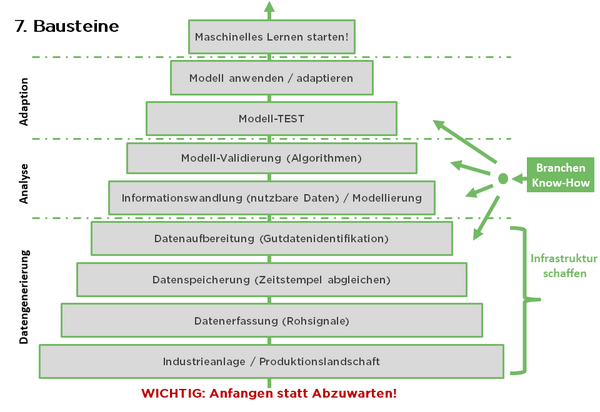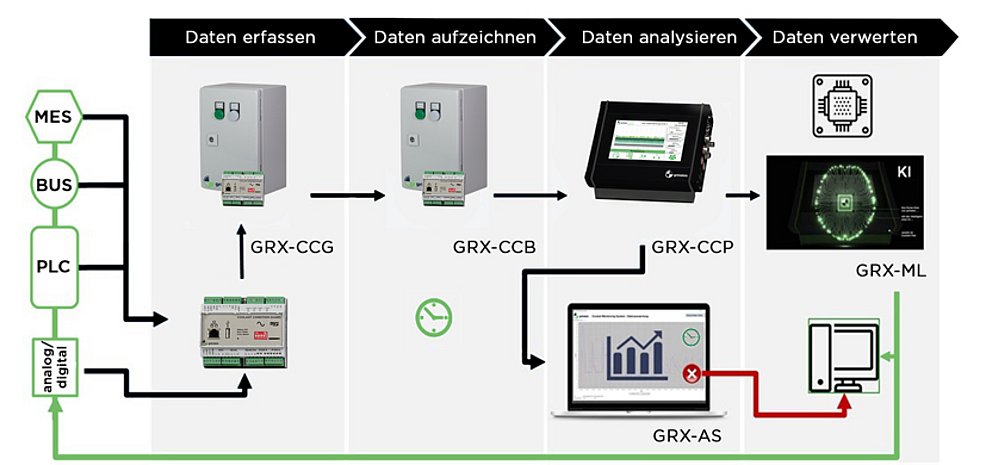AI - How do you proceed?
The first step in context is to start the implementation as soon as possible and not to wait for a competitor to come up with a solution. Because this solution, if it would be accessible at all, can certainly not be simply copied or purchased at the push of a button. Rather, solutions for the implementation of an autonomous production technology will have to be adapted to the specific characteristics of almost every production unit (location). This means that in the future there will probably be no generally valid solution approaches of a certain algorithm for all production units, which perhaps produce similar components with almost identical machines and automation systems. The use of artificially intelligent systems in the context of production engineering will most likely remain a company-specific endeavor with many different learning curves, the use of a wide variety of algorithms and their mathematical adaptation to the concrete application, with failures, successes and continuous improvement possibilities.
DETERMINE OPTIMISATION GOALS
As long as the optimization goals are specifically described and priorities are set - see Chapter 2: The vision of using artificial intelligence within production technology -
such as:
- Maximizing the number of good parts / hour = max {production output}
- Maximisation of profitability (€) = max {earnings per hour}
DATA IDENTIFICATION
The second step is to analyze which information (data) of the production unit has to be taken in order to monitor and achieve this optimization goal. It will quickly become apparent that there could be an infinite number of them. The art is therefore to identify the most relevant information (by priority). Once relevant information has been identified, the question arises as to how this information can be extracted from the production system. Not only the selection of a sustainably reliable and as accurate as possible low-maintenance sensor, but also its positioning within the production environment pose the first fundamental challenges. In the context of autonomous production, one speaks of the acquisition of so-called "good data".
The mathematical model of "artificial intelligence" is only truly "intelligent" in the sense of fulfilling previously defined optimization goals if the information fed to it is sustainably correct and it can learn to interact with it as error-free as possible. In this context, a correct date is not only its correct physical value, but also whether it is actually correct in the context of the optimization quantity that the respective information has a relevant influence on the optimization quantity. The more qualitative the information fed into the system (good data), the more usable are the statements (commands / recommendations) of the autonomous production control, and the sooner an optimization maximum is reached with respect to the clearly defined optimization goals.
DATA COLLECTION
In a third step, the question arises of how the data from the production environment can be transferred to a central EDP system with the least possible effort. According to current industry norms and standards, the cable solution is the most secure and at the same time the most robust solution. Often sensors are not WLAN-capable, the signal transmission can often be severely impaired by electromagnetic fields of the production equipment within the production environment, the signals are often unencrypted and thus unwantedly accessible to third parties (security).
It is therefore recommended to install the sensor signals on the production equipment via mature and pre-programmed switch boxes with a unique IP address (information origin) and then to route these signals very securely, digitally via a preconfigured bus system to a central point of use. There, the signals are first recorded cleanly in parallel with a time stamp that is uniformly valid for the entire production unit.
An exemplary structure of such a preconfigured data acquisition system is shown in the following figure 3.

It is possible to set up such a data acquisition system with your own personnel under your own direction by purchasing the many different electronic components. In most cases, however, it turns out that this is much more time-consuming and cost-intensive than using fully developed installation packages. It is important to ensure that these data acquisition systems function independently of sensor types and manufacturers in order to guarantee the user maximum application flexibility. It is also an advantage to find a service provider in this respect who can design, install, commission, sustainably maintain, technically update, expand and regularly service the system on site in accordance with requirements.
DATA STORAGE
Such commercially available preconfigured data acquisition systems also provide the technically clean data storage function including the necessary hardware and software. In this case, all recorded data is provided with a uniform time stamp. The exact identification of the data origin (IP address) assigns the information to a mechanical component (machine, pump, valve, aggregate, ...) and the time stamp provides the corresponding time allocation of a sensor value. These two pieces of information are essential for the later use of "artificial intelligence" in production technology. Without the exact assignment of the data origin and the exact time of the data value, parallel events cannot be mathematically and logically linked by the software-based intelligence to be installed later. The quality of this unambiguous provision of data is therefore an essential part of the quality of successful production autonomy.
Once the data has been properly stored, including IP address (origin) and time stamp, it must be made available in such a way that it can be easily found if required (integrated search function) and used by further processing software programs (data formats). For security reasons, it should also be possible to carry out regular data backup processes automatically. At best, the acquired unit of your data acquisition system can do this fully automatically.
DATA EVALUATION
Now, before feeding relevant data into the mathematical models (algorithms) of your AI (artificial intelligence) software, there is the possibility of enabling the full, previously unknown potential of such data use via practical monitoring functions. For example, users can easily program limit values for the acquired data via the central control unit included in the scope of delivery and thus very easily describe case events in order to achieve a monitoring function that meets the requirements. The central control unit visualizes limit value violations, outputs them in an error log and can transmit gross limit value violations (amount/duration) to a higher-level production control system or the monitored mechanical system (machine, pump, etc.). This leads, as a successful consequence, to the avoidance of scrap production. If, in addition, plausibilities, i.e. the simultaneous occurrence of different case events, are programmed (if - then principle: e.g. if pressure p1 < pressure p2 - then message error 18), the system will then already function successfully within the framework of a "predictive maintenance approach". The advantage of this machine-independent data acquisition system is mainly based on the fact that it overlooks the interaction of all production equipment monitored and can draw technical conclusions from this. The individual machine, no matter how modern it is, or the individual mechatronic production unit alone cannot do this. These individual components of the entire value-added chain are usually only able to optimize their own function, but not their optimal function in the context of the other means of production. Thus, a central data acquisition system in production engineering provides, beyond the monitoring and predictive maintenance capability, the possibility of technical communication between the installed means of production. This is the essential difference and at the same time the justification of demand with regard to such a superordinate monitoring system.
DATA EVALUATION (KI IMPLEMENTATION)

In this article relevant products:
These articles from our magazine may also interest you:
Advantages of Coolant Monitoring Systems
Coolant monitoring systems can contribute significantly to increasing reliability and efficiency by collecting and evaluating various measurement and status data in the cooling lubricant system.
Lubricoolant pressure control systems
Pressure control systems are particularly relevant for large and complex cooling lubricant supply systems. We have compiled the advantages over conventional pressure control systems and outline the technical implementation of an adequate pressure control.
AI - Challenges
The challenge of using artificial intelligence in production engineering is to generate data whose values are as correct as possible (good data).
AI - possibilities
The possibilities that result from the successful use of a production environment that is monitored according to requirements and controlled by artificial intelligence are diverse and often unexpectedly high in potential.








